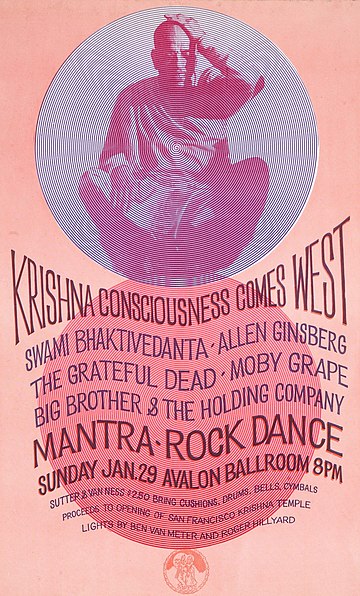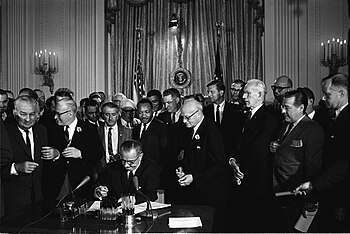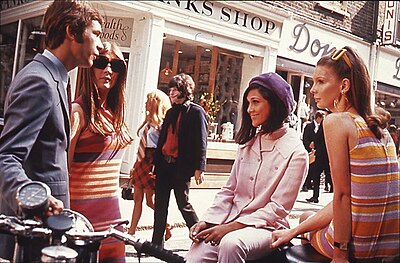Featured picture 1
Portal:1960s/Featured picture/1

American folk singers Joan Baez and Bob Dylan, performing a duet at the March on Washington for Jobs and Freedom on August 28, 1963. Both were relatively new recording artists at the time, with Baez being at the forefront of American roots revival and Dylan having just released his second album. Baez was especially influential in introducing audiences to Dylan's music by recording several of his early songs and inviting him onstage during her own concerts.
Featured picture 2
Portal:1960s/Featured picture/2

The Mantra-Rock Dance musical event took place on January 29, 1967, at the Avalon Ballroom in San Francisco and came to be dubbed as the "ultimate high" and the "major spiritual event" of the hippie era. It was organized by the early followers of the Hare Krishna movement as a promotional and fundraising effort for their first temple on the West Coast. One of them, Harvey W. Cohen, created the Stanley Mouse inspired promotional poster (pictured). The Mantra-Rock Dance featured the Hare Krishna founder Bhaktivedanta Swami, the countercultural ideologues Allen Ginsberg and Timothy Leary, and leading rock groups the Grateful Dead, Moby Grape, and Janis Joplin with Big Brother and the Holding Company. The event caused the Hare Krishna mantra to be adopted by all levels of the counterculture as a "loose commonality" and a viable alternative to drugs.
Featured picture 3
Portal:1960s/Featured picture/3

United States President Lyndon B. Johnson (seated) signs the Civil Rights Act of 1964, a landmark piece of legislation that outlawed racial segregation in schools, public places, and employment. Among the guests behind him is Martin Luther King Jr. (directly behind and to the right of Johnson).
Featured picture 4
Portal:1960s/Featured picture/4

Crowds surrounding the Reflecting Pool, during the August 28 1963 March on Washington for Jobs and Freedom. An estimated 200,000 to 500,000 people participated in the march, which featured Martin Luther King Jr.'s famous "I Have a Dream" speech. It was a major factor leading to the passage of the Civil Rights Act of 1964 and the 1965 Voting Rights Act. The march was also condemned by the Nation of Islam and Malcolm X, who termed it the "farce on Washington".
Featured picture 5
Portal:1960s/Featured picture/5

Charlton Heston (1923–2008) was an American actor of film, theatre and television who is known for heroic roles in films such as The Ten Commandments, Ben-Hur (for which he won the Academy Award for Best Actor), El Cid, and Planet of the Apes. Heston was also known for his political activism. In the 1950s and 1960s he was one of a handful of Hollywood actors to speak openly against racism, and was an active supporter of the Civil Rights Movement. Initially a moderate Democrat, he later supported conservative Republican policies and was president of the National Rifle Association from 1998 to 2003.
Featured picture 6
Portal:1960s/Featured picture/6

Lyndon B. Johnson taking the U.S. Presidential Oath of Office on Air Force One following the assassination of John F. Kennedy in Dallas on November 22, 1963. He was sworn in by Judge Sarah T. Hughes, making him the first President sworn in by a woman. Johnson was not sworn using a Bible; none could be found aboard the plane. A Roman Catholic Missal was discovered in Kennedy's desk, and this book was used during the swearing-in ceremony.
Featured picture 7
Portal:1960s/Featured picture/7

Malcolm X was an American Black Muslim minister and a spokesman for the Nation of Islam. Born Malcolm Little, he changed his surname to "X" as a rejection of his "slave name". Tensions between him and the Nation of Islam caused him to break from the group in 1964. He claimed to have received daily death threats and his house was burned to the ground in February 1965. One week later, Malcolm X was assassinated, having been shot in the chest by a sawed-off shotgun and 16 times with handguns. Three members of the Nation of Islam were convicted.
Featured picture 8
Portal:1960s/Featured picture/8

United States Attorney General Robert F. Kennedy speaking at a civil rights demonstration organized by the Congress of Racial Equality (CORE) on the steps of the Department of Justice building in June 1963. Kennedy's tenure (1961–64) was easily the period of greatest power for the office; no previous officeholder had enjoyed such clear influence on all areas of policy during an administration. As Attorney General, Kennedy pursued a relentless crusade against organized crime and consistently championed civil rights for African Americans, the latter so much so that he commented, in 1962, that it seemed to envelop almost every area of his public and private life.
Featured picture 9
Portal:1960s/Featured picture/9

Attempting to block racial integration at the University of Alabama, Governor George Wallace (left) stands defiantly at the door on June 11, 1963, in an incident known as the Stand in the Schoolhouse Door. Wallace moved aside after being ordered to do so by President John F. Kennedy; years later, he became a born-again Christian and recanted his segregationist views.
Featured picture 10
Portal:1960s/Featured picture/10

Photo taken by a Lockheed U-2 spy plane of the San Cristobal MRBM launch site in Cuba, November 1962, after the Cuban Missile Crisis. Although this image was taken days after the crisis had ended (October 28), this image has become iconic of the crisis to the point where it is often cited incorrectly as having been taken during the crisis.
Featured picture 11
Portal:1960s/Featured picture/11

Joseph Kittinger sets world records for the highest parachute jump, the longest parachute drogue fall and the fastest speed by a human through the atmosphere after jumping from Excelsior III.
Featured picture 12
Portal:1960s/Featured picture/12

Christine Keeler, best known for her involvement in the Profumo Affair, which lead to the resignation of British Prime Minister Harold Macmillan.
Featured picture 13
Portal:1960s/Featured picture/13

In the 1960s, Carnaby Street in London was the center for trends and fashions.
Featured picture 14
Featured picture 15
Featured picture 16
Featured picture 17
Featured picture 18
Featured picture 19
Featured picture 20
Usage
The layout design for these subpages is at Portal:1960s/Featured picture/Layout.
- Add a new Featured picture to the next available subpage.
- Update "max=" to new total for its {{Random portal component}} on the main page.
Additions
Feel free to add related featured pictures to the above list.
